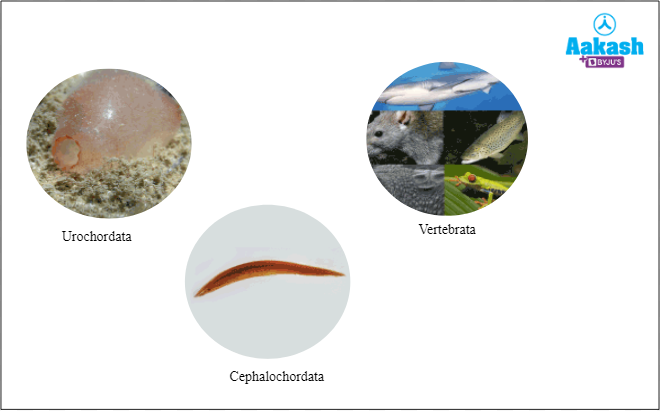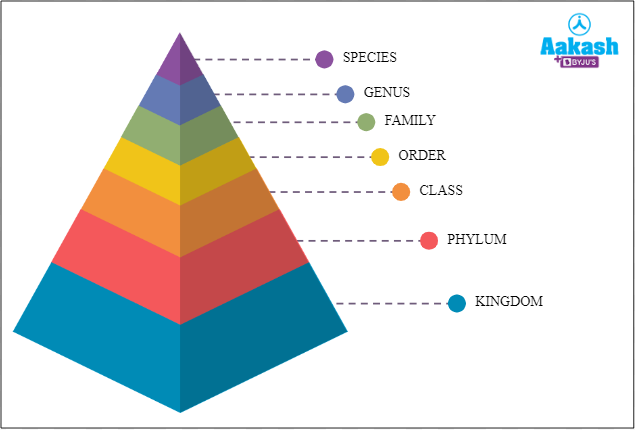-
Call Now
1800-102-2727
Taxonomic Hierarchy, Practice Problems and FAQs
Have you ever wondered how different organisations such as schools, hospitals, banks, etc., organise their data? You must have noticed that these places generally have archives crowded with wall high cabinets in which every drawer is labelled with the information of the type of data it contains. For example in a school, there might be different cabinets for information on admissions, Board examinations, Annual activities, etc. Each cabinet in turn might have separate drawers to hold information pertaining to different academic years and the drawers in turn might have different folders for different types of documents. This level of organisation requires that all the available information is categorised into different groups. But what is the purpose of putting in this much effort? The reason data needs to be organised is because the sheer volume of information is so high that without categorising it and arranging it into groups, it will be very difficult to retrieve information or refer to it as and when needed.
A similar requirement arises when we aim to study the living world. There are millions of species of organisms inhabiting this planet and only 1.7-1.8 million of these have been identified so far. Thus, studying this vast world of living beings needs a proper classification system and taxonomy is the branch of biology that helps in achieving this. The categories used for classification are arranged in a hierarchy based on the degree of similarity amongst their members. This is known as taxonomic hierarchy and that is what we are going to discuss in this article.
Table of content:
Taxonomy
Taxonomy is the branch of science involved with the arrangement of organisms into individual groups or categories. The organisms that closely resemble each other are placed in one group and the groups having similarities are combined together into larger groups, and these into larger ones. The various grouping ranks or levels in classification are known as categories. The term ‘taxon’ is used to represent the actual biological objects included in a category. Adolf Meyer, a German biologist, first introduced the term ‘taxon’.

Fig: Classification of organisms
Taxonomy utilises information related to morphology, anatomy, histology, physiology, cytology, genetics, molecular biology etc of an organism to classify it under a specific taxon. Thus, it is considered to be a multidisciplinary and dynamic branch of biology. Taxonomy helps in establishing the evolutionary relationship between organisms.
Steps of modern taxonomy
The steps of modern taxonomy are as follows:
- Characterisation and identification
- Classification
- Nomenclature

Fig: Steps of modern taxonomy
After the characterisation and identification of an organism, the organisms are scientifically arranged or classified in a hierarchical series of groups and subgroups on the basis of the similarities and differences in their traits so as to bring out their relationships.
Taxonomic categories
Category is a unit of grouping in a system. Taxonomic category is a subunit of grouping of any level used in taxonomy or classification of organisms. Usually there are seven obligate and a few intermediate categories used in taxonomy. The taxonomic categories which are always used in hierarchical classification are called obligate categories. The seven obligate categories are - species, genus, family, order, class, phylum/division and kingdom. However, the seven obligate categories were unable to meet the requirement of huge diversity found in organisms with the discovery of a large number of species in later periods. Therefore, some new categories were introduced in between the obligate categories for accommodating characteristics of certain groups with more precision. These are known as the intermediate categories, for example, sub-class, super-class, subspecies, etc.
Species
Species is the lowest unit of classification. In sexually reproducing organisms, interbreeding is the basic criterion for delimiting a species. Thus, a species is defined as a group of organisms that closely resemble, freely interbreed and produce fertile offspring. Members of the same species possess similar genetic material but members of different species are genetically distinct from each other and are reproductively isolated.
The scientific name of any organism has two parts, the first being the genus and the second being the specific epithet. Lion (Panthera leo), tiger (Panthera tigris) and leopard (Panthera pardas) are members of the genus Panthera but but they belong to three different species, which are leo, pardas and tigris.

Fig: Genus with two different species
Genus
The next higher category is the genus. Genus consists of a group of related species that have more characteristics in common than species belonging to another genera. For example, tomato (Solanum lycopersicum), brinjal (Solanum melongena) and potato (Solanum tuberosum) belong to three different species that are classified under the same genus, that is, Solanum.
Family
Family is a group of related genera and these genera have even less similarities compared to the related species that come under a genus or individuals that come under the same species.
For example, animals included in genus Panthera (lions, tigers etc.) as well as in genus Felis (cats) fall under the family Felidae. Foxes and dogs belong to the family Canidae.

Fig: Family Felidae
The plant genera Atropa, Datura, Petunia etc. fall under the family Solanaceae.

Fig: Family Solanaceae
Order
Order is the next higher category and includes related families. Families in an order exhibit even lesser similarities in characteristics than genera in a family. For example, both the families Canidae and Felidae fall under the order Carnivora, In plants, families Leguminosae and Rosaceae are included under the order Rosales.

Fig: Order Carnivora
Class
Related orders are grouped under a class. The similarities between orders under a class are even less than the similarities between families under an order. For example - in plants, orders like Ranales, Parietales, Geraniales, Rosales etc are put under order Dicotyledonae. In animals, orders such as Carnivora, Primata (including apes, gibbons, humans, etc) and Rodentia (including rats, mice, etc) fall under the class Mammalia.
Phylum or Division
Phylum includes different classes of animals or plants having very few similarities. The term Phylum is used in the classification of animals and the term Division is used in the classification of plants. For example, division Thallophyta includes class Rhodophyceae (red algae), class Phaeophyceae (brown algae) and class Chlorophyceae (green algae).

Fig: Examples of division Thallophyta
In animals, phylum Chordata includes class Cyclostomata, Osteichthyes, Chondrichthyes, Reptilia, Amphibia, Aves and Mammalia.

Fig: Examples of phylum Chordata
Kingdom
The highest category in the hierarchy of taxonomic categories is Kingdom which includes all the related phyla. For example, all the phyla comprising animals fall under kingdom Animalia and all the phyla comprising plants fall under kingdom Plantae. According to Whittaker’s five kingdom classification of the living world, the five kingdoms are Monera (unicellular prokaryotes), Protista (unicellular eukaryotes), Mycota (fungi), Plantae and Animalia.
Taxonomic Hierarchy
Hierarchy is a system in which members of a type are organised in ranks one above the other. Hierarchy of categories or taxonomic hierarchy is the system of arrangement of taxonomic categories in a descending order depending upon their relative dimensions. It was introduced by Linnaeus (1751) and is therefore also known as the Linnaean hierarchy. Linnaeus proposed six categories - kingdom, class, orer, genus, species and variety. Later workers deleted the category of variety and added the categories phylum/division and family. The obligate categories in the descending hierarchy are - kingdom, phylum/division, class, order, family, genus and species.

Fig: Categories in taxonomic hierarchy

Fig: Taxonomic hierarchy
All the members of a taxonomic category possess some similar characters which are different from those of others. For example, all members of class insecta possess three pairs of jointed legs. Jointed legs occur in other classes of phylum arthropoda as well but their number is different.
Examples of taxonomic categories of common organisms
|
Common Name |
Biological Name |
Genus |
Family |
Order |
Class |
Phylum/Division |
|
Man |
Homo sapiens |
Homo |
Hominidae |
Primata |
Mammalia |
Chordata |
|
Mango |
Mangifera indica |
Mangifera |
Anacardiaceae |
Sapindales |
Dicotyledonae |
Angiospermae |
|
Wheat |
Triticum aestivum |
Triticum |
Poaceae |
Poales |
Monocotyledonae |
Angiospermae |
|
Housefly |
Musca domestica |
Musca |
Muscidae |
Diptera |
Insecta |
Arthropoda |
Practice problems
1. Which of these following families does wheat belong to?
- Sapindales
- Anacardiaceae
- Poaceae
- Poales
Solution: The taxonomic classification of wheat is -
Species - aestivum
Genus - Triticum
Family - Poaceae
Order - Poales
Class - Monocotyledonae
Division - Angiospermae
Kingdom - Plantae
Thus, the correct option is c.
2. Which of the following is the odd one out?
- Felidae
- Carnivora
- Primata
- Rodentia
Solution: Felidae is the odd one out as it is a family including genera such as Panthera (tigers, lions, etc) and Felis (cats). Carnivora, Primata and Rodentia are orders that come under class Mammalia. Thus, the correct option is a.
3. Which of the following categories have the least number of similarities between its members?
- Genus
- Order
- Family
- Species
Solution: As we go up the hierarchy of the taxonomic categories, the similarities between the members of each category decreases. Species is the lowest taxonomic category and members of a species have the highest degree of similarity. Species of a genera have less similarity than the individuals of a species. Related genera of the same family have even less similarity and the families falling under an order have further less similarity than genera of a family. Thus the least amount of similarity exists between families under an order. Hence, the correct option is b.
4. Choose the correct pair:
- Panthera - species
- parda - genus
- Musca - genus
- Diptera - family
Solution: Panthera is the genus and parda is the species to which a leopard belongs. Musca is the genus and Diptera is the order to which house flies belong. Thus, the correct option is c.
FAQs
- What is the common suffix for plant and animal families?
Answer: Plant families have the suffix ‘-aceae’ and animal families have the suffix ‘-idae’.
- What is subspecies and variety?
Answer: Subspecies and variety sub groups of species used for animals and plants, respectively. This subcategory consists of one or more populations which have certain characteristics which distinguish its members from other members of the species.
- What are the different subspecies under Homo sapiens?
Answer: The two subspecies under Homo sapiens are - Homo sapiens sapiens including modern man, Homo sapiens fossilis including Cro-Magnon man, Homo sapiens neanderthalensis including neanderthal man and Homo sapiens heidelbergensis including Heidelberg man.
- What is a cultivar group?
Answer: A cultivar-group, presently known as a group, is a formal category for cultivated plants sharing a defined characteristic that is identified in the International Code of Nomenclature for Cultivated Plants (ICNCP). In the botanical name, the symbol Group or Gp with a capital G is used to represent this category. It is not italicised in the botanical name.
YOUTUBE LINK: https://youtu.be/VXGFMHBsJtk



